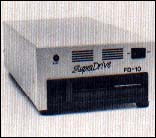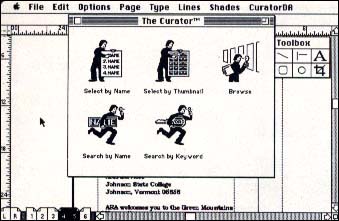Mac and PC On The ST
Hard Drive Help And Curator
BY DAVID PLOTKIN
START CONTRIBUTING EDITOR
As long-time owners of Magic Sac have learned, using a hard drive is pretty complicated. Data Pacific has devoted much time, effort and documentation to instruct users about it. To be fair, the fault is not Magic Sac's; it stems instead from the fact that the original 64K Apple ROMs (which are what the Magic Sac uses) really weren't set up properly to use a hard drive. The newer 128K Apple ROMs used in Gadgets by Small's Spectre 128 are designed to work with a hard drive, making hard drive installation quite a bit simpler.
 |
| Supra's FD-10 works quite well with Spectre 128--and you don't have to devote a hard disk parti- tion to Mac programs and files. Use the Spectre 128 hard disk formatting function with SCSI device #4. |
If you want to use a hard drive with Spectre 128, you'll have several options. First of all, you can instruct Spectre 128 to reformat one partition of your hard disk. The partition must have been previously formatted for TOS and once Spectre 128 has reformatted it, it will no longer be available to your ST except when you are running Spectre 128. And, as usual, reformatting the partition erases everything on it. A word of caution: it's best to assign the last partition on your drive to Spectre 128--otherwise TOS may not be able to read any partitions beyond it.
You need to know a few things first. When you format a hard drive partition under Spectre 128, the default settings assume that you want to boot from the hard drive. Of course, you probably will want to do this eventually, but you must first install the System Folder (containing the System and Finder) on the hard drive. If you run Spectre with the hard drive autoboot set, but without the System and Finder on the hard drive partition, the result will be a complete system crash (trust me on this one--I tried it).
Further, until you set Spectre 128 up properly to autoboot from the hard drive, the hard drive icon will not automatically show up on the Desktop. To get it to appear, you must press a Function key (typically F3-- for the first Spectre hard drive partition). If you do autoboot from the hard drive, however, then the hard drive icon does show up automatically.
The Floppy Alternative to a Hard Disk
If you own one of Supra's FD-10 "super floppies," which store 10 megabytes on a specially formatted 5 1/4-inch floppy, you will be delighted to know that this device works quite well with Spectre 128. It is an SCSI device and Supra sets its identification number to 4. To format a FD-10 floppy, you just use hard disk format under Spectre 128, setting the SCSI ID to 4. Since you can interchange the floppies, you aren't giving up one of your hard disk partitions permanently.
Mac Graphics and Curator
Once you are up and running on your Mac hard drive, you'll want to start putting programs on it. One nice thing about many Mac programs is that they can accept clip art from other programs through various methods, including (if all else fails) the clipboard. Thus, clip art has become very popular in the Mac world and there are many commercial and public domain clip art packages available. The handiest collections are Current Notes' Magic Sac PD Library. The clip art is already in Magic Sac format, and the price is right. The Current Notes library also includes many games and fonts as well, all tested to run under Magic Sac/Spectre.
There are many graphics "standards" for Mac graphics and though most programs can read and save files in several of the formats, it's helpful to have a conversion program. Curator from Solutions International is such a program, but converting among the seven different graphics formats it supports is only one of the program's many useful features. Curator is easy to use--it's all menu driven and uses intelligently designed dialog boxes.
Curator can be used either as an application or desk accessory so that its capabilities are available within other programs. Changing the format of a graphics file (including clip art) is quite simple--just open the file under Curator, then save it with a different name, specifying the save format. Common file formats, such as MacPaint, PICT (MacDraw), EPS (Encapsulated Postscript) and TIFF (scanned documents) are all supported, although not every format can be converted to every other format.
Finding That Elusive Clip Art
Another useful feature of Curator is that it can help you locate the particular graphics you need. As your collection of graphics grows, it can become difficult to find the file containing the one piece of clip art you want to use. Curator can find graphics by filename, partial filename, keyword or thumbnail. These last two are very useful. Curator lets you associate special keywords with a graphics file. These keywords are then stored in a catalog so that by specifying one or more keywords, you can find files with any or all of those keywords. Any file that matches the specification has its thumbnail sketch displayed--a thumbnail sketch is a reduced representation of the graphics in the file--so you can get an idea of the contents of a graphics file without having to open it. When searching by thumbnail sketch, Curator even presents you with a window containing thumbnail sketches of all the cataloged graphics on your disk.
 |
| Curator from Solutions International is a Macintosh program that not only converts among seven common Mac graphics formats, but also helps you to locate that particular piece of clip art for your masterpiece. |
Once you have found the file you want to use, you can open it under Curator. If you were looking for the file by thumbnail, opening the file is as simple as double-clicking on the thumbnail sketch. The full-size contents of the file are shown in a window and you can cut any portion (or the whole graphic) to the Mac's clipboard. This is quite handy; for example, let's say you're using MacDraft, a drafting package which doesn't understand any of the seven file formats supported by Curator, but can accept graphics from the clipboard. Using the Curator Desk Accessory, you can locate the graphic you need, open it, cut out a piece to the clipboard, close up Curator and then paste the contents of the clipboard into MacDraft. Before Curator, you would have to quit MacDraft and use another application (such as MacPaint) to paste a graphic (if you could find the right one) to the clip board, then restart MacDraft and paste the graphic into the document.
There is one problem in running Curator under Spectre 128 or Magic Sac. The Browse function, which lets you work with the keywords for all graphics at once (as opposed to the keywords of a single graphics file at a time) causes a system crash if you try to open a graphics file. Aside from this problem (which you can work around), Curator works well and fulfills a very real need. Now, if someone would just write such a program for the ST!
START Contributing Editor David Plotkin is a chemical engineer for Chevron U.S.A. and has published several articles in START and Antic.
PRODUCTS MENTIONED
Public Domain Clip Art Disks, $4.00. Current Notes, 122 N. Johnson Rd., Sterling, VA 22170.
Magic Sac+, $149.95. Data Pacific, Inc., 609 West Speer Blvd., Denver, CO 80203, (303) 733-8158.
Spectre 128, $179.95. Gadgets by Small, Inc. 40 West Littleton Blvd., #201-211, Littleton, CO 80120, (303) 791-6098.
Curator, $139.95. Solutions international, 30 Commerce Street, Williston, VT 05495, {802) 658-5506.
FD-10 Floppy Disk Drive, $995. Supra Corp., 1133 Commercial Way Albany, OR 97321, (503) 967-9075.